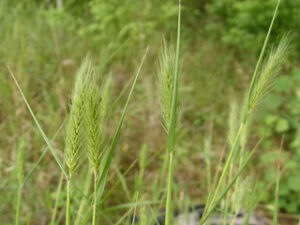by CMG Betty J
The Texas Hill Country is a defined area of nineteen counties situated within the Edwards Plateau. Since the region takes up about 24 million acres, the diversity of its flora and fauna reflects that vast size. Some 280 species of grasses are found here. Some are native and some have been introduced, either intentionally or not. Texas Parks and Wildlife lists the five most common grasses for the Edwards Plateau as silver bluestem, Canada wildrye, big muhly, little bluestem and Indian grass.
Native grasses provide food for wildlife and some grazing for cattle. The deep grass roots protect slopes from erosion and keep the soil from compacting so water can seep into the aquifer below.

Canada Wildrye
Canada wildrye, Elymus Canadensis, is a tall, native bunchgrass. A cool season perennial grass, it has seedhead spikes that resemble wheat or barley. The seedheads droop downward giving it another common name, nodding wildrye. The young plants are a nutritious forage and the thick bunches provide good cover for small mammals and birds. It is the larval host to the zabulon skipper butterfly and blooms in March with seedheads forming from May through December.